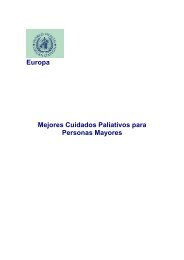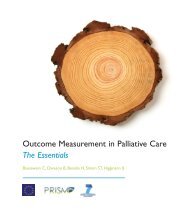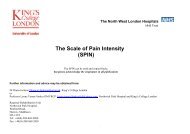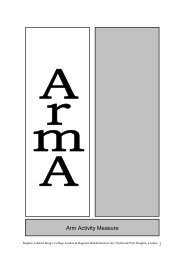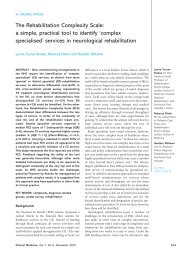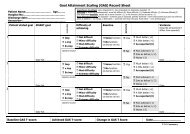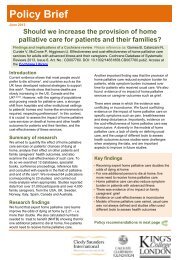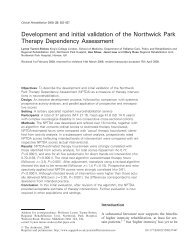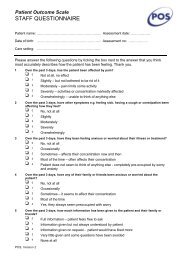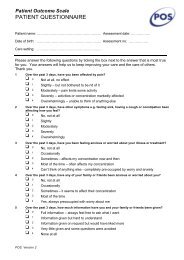2004 - 2007 - Cicely Saunders Institute - King's College London
2004 - 2007 - Cicely Saunders Institute - King's College London
2004 - 2007 - Cicely Saunders Institute - King's College London
You also want an ePaper? Increase the reach of your titles
YUMPU automatically turns print PDFs into web optimized ePapers that Google loves.
As part of the project, resources have been developed<br />
to support people affected by MS and health and social<br />
care professionals, including a referral pathway for care<br />
professionals and a paper and web-based service<br />
directory (see section 4.1).<br />
The palliative care needs of people with<br />
late stage Parkinson’s Disease (PD), Multiple<br />
System Atrophy (MSA), and Progressive<br />
Supranuclear Palsy (PSP)<br />
Building on our earlier research we have commenced a<br />
new study, supported by the Department of Health (UK)<br />
to understand the experiences and needs of people<br />
severely affected by PD, MSA and PSP in order to identify<br />
the most effective approaches to enhancing quality of life<br />
and providing flexible personalised support. Patients and<br />
carers are recruited to a longitudinal study, which<br />
measures symptom problems and costs of care.<br />
2.1.3 Evaluating and Improving the Costefficiency<br />
of Rehabilitation<br />
There is now reasonable evidence to support the costeffectiveness<br />
of rehabilitation following brain injury 84 .<br />
But which patients may benefit most?<br />
Routine collection of data in the course of clinical<br />
practice is key to the demonstration of effective and<br />
cost-efficient practice. Within this three-year cycle,<br />
Turner-Stokes et al have analysed a six-year longitudinal<br />
cohort 251 to examine whether our rehabilitation<br />
programme is effective in reducing long term care<br />
needs, such that it could pay for itself through reducing<br />
the cost of on-going care. The programme uses<br />
measures developed in earlier research (see section 2.3).<br />
It is often thought that rehabilitation is not worthwhile for<br />
very severely dependent patients because they will remain<br />
dependent on care to some degree. However, our study<br />
showed that, contrary to expectation, rehabilitation was<br />
in fact most cost-effective for these heavily dependent<br />
patients. Although they required longer periods of<br />
rehabilitation, and thus cost more to treat, the gains<br />
in reduction of care costs were much higher than in the<br />
less dependent group, so the initial cost of rehabilitation<br />
was more quickly offset by savings in on-going care 252 .<br />
Moreover, serial analysis of change in dependency for the<br />
most dependent and long-staying patients confirmed that<br />
they continued to make changes throughout their<br />
admission, and that earlier discharge would have led to<br />
poor outcomes and increased care needs 313 .<br />
The Functional Independence Measure (FIM TM ) is widely<br />
used in the USA and Europe as an outcome measure for<br />
rehabilitation and benchmarking of services and FIMefficiency<br />
(Gain in FIM score / Length of stay) is often<br />
used as a surrogate for cost-efficiency. A further<br />
interesting finding from this study was that the FIM did<br />
not demonstrate the additional cost benefits of rehabilitation<br />
in the highest dependency group that were<br />
revealed by the group’s new measure, the NPDS (see<br />
figure 2.4) 314 .<br />
2.1.4 Improving Care and Services for People<br />
Affected by HIV or AIDS<br />
In the era of antiretroviral therapy (ART), palliative care has<br />
a new and evolving role in supporting treatment, as well as<br />
caring for those for whom treatment is either not available<br />
or cannot prevent disease progression. All of these groups<br />
may require palliative care to address the physical,<br />
spiritual and emotional pain related to the disease and its<br />
treatment. It should be remembered that there are<br />
significant excess risks associated with HIV infection for<br />
several cancers, including Kaposi’s Sarcoma, lymphoma,<br />
vulval and cervical cancer; linking our work in this<br />
programme very directly with our cancer programme.<br />
Harding and Higginson have been collaborating in the<br />
USA, UK and Africa to investigate the palliative care<br />
needs of patients with early as well as advanced disease,<br />
both in resource-rich and resource-poor countries.<br />
Change in FIM score<br />
Change in NPDS score<br />
100<br />
20<br />
80<br />
10<br />
60<br />
0<br />
Change in Total FIM<br />
40<br />
20<br />
0<br />
-20<br />
-40<br />
N= 83<br />
Low<br />
Dependency group<br />
111<br />
Medium<br />
102<br />
High<br />
Change in NPDS score<br />
-10<br />
-20<br />
-30<br />
-40<br />
-50<br />
-60<br />
N= 82<br />
Low<br />
Dependency group<br />
111<br />
Medium<br />
100<br />
High<br />
Figure 2.4 Comparison of the change in FIM (old measure) and NPDS (new more sensitive measure) scores across the three dependency groups.<br />
Box plots show median, inter-quartile range, range and outliers<br />
Source: Turner-Stokes et al, Arch Phys Med Rehab 2006; 87(11) e11.<br />
6




